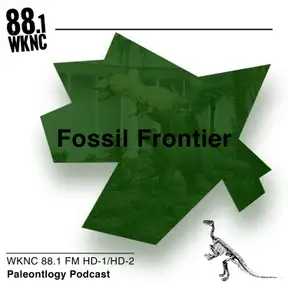Terror Birds: The Invasion of Prehistoric Predators
Download MP3Scrimble 0:05
Hello everybody. I'm Scrimble and welcome to the sixth episode of my podcast, fossil frontier, a paleontology podcast brought to you by wknc 88.1
this show will be dedicated to talking about my favorite fossils and prehistoric phenomena. We're going to explore some of Earth's ancient treasures and uncover the stories that they have to tell. So if that's something you're into, you better lock in, because this week we're talking about terror birds. These prehistoric birds became one of the largest apex predators in the Cenozoic era. So let's jump right in.
Okay, So picture this. It's South America in the Pliocene epoch around 5 million years ago, a capybara wanders the plains looking for food. Since there are very few apex predators in this region, the rodent is calm and uncaring, that is, until a large bird is spotted running up to it. As the massive, flightless bird gets closer, you can see that it's almost 10 feet tall and weighs over 750 pounds. The Capybara tries to run, but the predator is faster, running at its full speed of 30 miles per hour, it quickly sinks its huge claws into the animal, holding it down from moving. But unfortunately, this won't be a quick death.
As the capybara cries out, the bird picks it up and begins shaking it and slamming it to the ground. Eventually, the loud calls fade into whimpers that die out quietly. The giant bird then begins to use its sharp, 18 inch long beak to pick the flesh from the bone, just another afternoon snack for this apex predator.
This bird, if you haven't already guessed, is the Titanus, a genus of the Phorusrhacidae, or terror bird family. These guys lived from about 43 to 2.5 million years ago, and as their name suggests, they terrorized rodents, mammals, reptiles and any other animal they could sink their claws into. In South America, there were about 25 species of terror birds running around, each with their own characteristics, with very few competitors on their level of the food chain, they were very successful predators with many adaptations used to subdue and kill their prey, like their massive claws for stabbing or their giant skulls that were actually fused together, which allowed them to peck their prey to death. Some were even thought to be scavengers, picking through animals killed by other predators. But no matter how they got their food, one thing remains to be true, they were good at it. You see, these guys were living in a post Dinosaur World after the Cretaceous-Tertiary, or K-T extinction event that occurred 66 million years ago and killed the dinosaurs. It ushered in the Cenozoic Era. Earth and all its ecosystems were left with many evolutionary niches empty and ready to be filled by new animals soon, mammals, reptiles, and of course, birds were adapting to their new surroundings. It was kind of like the wild west out there where anyone could be anything. Just look at the ground sloths, giant sloths that burrowed in caves and ate ferns and the terror birds who evolved to fill the niche of apex predator in the delicate South American ecosystem.
But this wasn't just a time of biological change. The Cenozoic Era also harbored significant geological change as well. With the separation of Pangea. You see, after South America broke away from Africa, it began to drift to the location where we know it today, underneath North America, over time, the two continents would connect to each other through Central America, and this allowed animals to migrate between the continents. For the first time, though they were birds, the terror birds were flightless and relied on walking or running to get where they needed to go, this was never an issue for them. However, because their powerful legs were more than enough to catch their prey. Because they were so successful, it was only natural for them to spread their territory farther north. So about 3 million years ago, before the bridge between continents was even fully developed, early immigrants like the Titanus began island hopping to get to North America. This was called The Great American exchange. But what the Titanus found when they got there would alter their food chain forever, as unforeseen creatures lurked just beyond the border in.
When terror birds showed up, they were met with North American predators, from wolves to big cats to bears, for the first time in their millions of years of existence, they had real competition for food. They had to struggle to find prey and protect it from the other predators.
While this was likely a challenge at first, the birds' many intimidating adaptations were enough to keep them at the top of the food chain, albeit alongside the other apex predators in the ecosystem.
So there they were, the terror birds, already a big deal in South America and now slowly taking over North America too. Will their reign of terror ever end? Well, as you know, they're not around today, so obviously it did end. But what force was finally able to take down these massive, flightless carnivores for good?
Well, the answer is pretty simple, and it wasn't another even larger predator or some sort of giant extinction event. Rather, it was climate change.
The most recent Ice Age caused temperatures to drop, meaning longer winters and expanding glaciers. On top of the new competition found in North America, the terror birds just couldn't keep up. Even their giant stature and seasoned hunting strategy wasn't enough to keep them going, and most of them died out in North America around 2 million years ago. Thankfully, this was long before humans even existed, so there was no overlap between us and these gargantuan carnivores
Ultimately, while terror birds reign was short, it proved very successful and likely terrifying for any prey in their era. From the dense forests of South America to the grasslands up north, these formidable avian predators once ruled any ancient landscape that they found themselves in. They went from big fish in a small pond to just bigger than average fish in a large pond. But their migration and the Great American Interchange as a whole sparked a new era for the Americas, with new animals and plants being introduced for the first time, they were forced to adapt or go extinct, shaping the earth we know today,
but the story of the terror birds just goes to show when we take a risk and migrate to a new opportunity, we may just find out that we're stronger than we thought we were.
Thank you for listening to the sixth episode of fossil frontier. This has been a wknc podcast. Good night, and I love you.
The audio used in this podcast was Song Thrush, nature, field recording, garden atmo recorded by Garuda 1982 under Creative Commons license.
Transcribed by https://otter.ai

